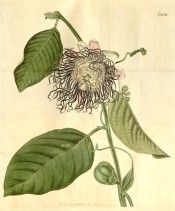Passiflora quadrangularis L.
Strong climber with ovate, un-lobed leaves, the flowers greenish outside, pinkish inside, corona white with bands of blue and reddish-purple. [RHSD, Hortus].
Horticultural & Botanical History
‘Cultivated in gardens in the West Indies, but whether indigenous there seems doubtful. The fruit is as large as a swan’s egg; its pulp is eaten with wine, either with or without its seeds, and much esteemed for its supposed cooling quality. From its quick growth and thick foliage, it is well suited for forming arbours and covered walks, but Jacquin observes that they are apt to be infested by venomous serpents, who choose the Passion-flowers, more especially this species and the laurel-leaved, for their abode, well knowing that their favourite prey, the squirrels, no where more abound, these animals being fond of these fruits.’ [BM t.2041/1819]. Introduced to Europe in 1763. [PD]. BR f.14/1815.
History at Camden Park
Desideratum to Loddiges’ nursery on 6th January 1845 [MP A2933-2, p.28]. I have found no further records and it may never have been grown at Camden.
Notes
Published Jan 31, 2010 - 04:48 PM | Last updated Jul 29, 2010 - 02:53 PM
| Family | Passifloraceae |
|---|---|
| Category | |
| Region of origin | Tropical America |
| Synonyms |
|
| Common Name | Granadilla |
| Name in the Camden Park Record |
Passiflora quadrangularis |
| Confidence level | high |
